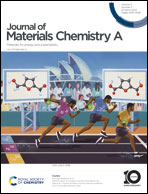Three-dimensionally semi-ordered macroporous air electrodes for metal–oxygen batteries†
Abstract
Metal–oxygen batteries (MOBs) are great candidates for next-generation energy storage systems due to their high safety, low cost, environmental friendliness, and especially high volumetric energy density. However, during the oxygen reduction process in MOBs, the solid discharge products can deposit/accumulate, clog the small pores of the air electrode, and block the transport of oxygen and various ion species in aqueous or non-aqueous electrolytes, therefore leading to increased impedance and shortened cycle life of MOBs. Herein, we demonstrate that a three-dimensionally semi-ordered macroporous (3D-SOM) structure of ruthenium/single-walled carbon nanotubes air electrode can largely alleviate detrimental effects due to the accumulation of reaction products during the discharge process, facilitating the smooth flow of active species, including oxygen and ions in an air electrode during the charge/discharge processes of MOBs such as non-aqueous lithium–oxygen and aqueous zinc–oxygen batteries. As a result, the 3D-SOM structured air electrode can be used as an effective approach to reduce the overpotential and impedance of MOBs, therefore enhancing their capacity and cycle life.



 Please wait while we load your content...
Please wait while we load your content...